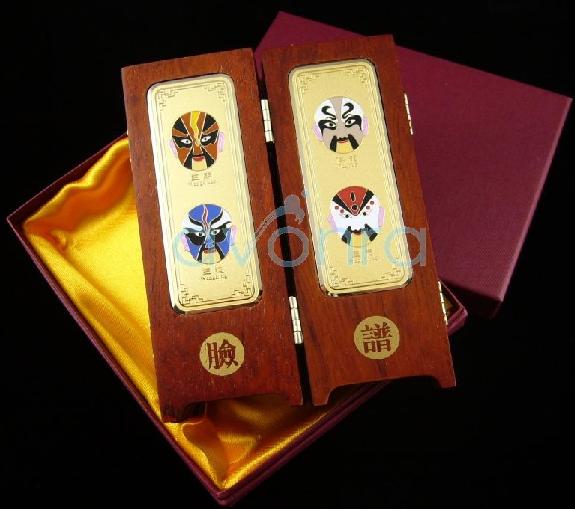
Features :
Chinese Mask Fine Art Small Wall
The facial made-up of Chinese Peking Opera is a procedure of facial making-up of the actors and actresses, and it is general applied to "painted-face" characters and clowns, among whom most have their individual styles and colors in order to highlight characteristic features of characters. It has the artistic feature of praising and blaming, as well as telling virtue from evil. The audience may see the inside world of characters from their appearances, so that facial make-up is referred to as "inside picture" of characters.
Peking Opera facial make-up is an art of portrayal and exaggeration. The patterns of bat, bird wings and butterfly wings are often used to paint eyebrows and faces of characters, together with exaggerated nasal pits and mouth pits to highlight facial expressions. Colors, such as red, yellow, blue, white, black, golden and silver have their own meanings. Patterns and decorations are specific representation of the inside world and outside appearance of characters. All of these are rich in culture.
Gold and silver colors are usually used for gods and spirits. The main color in a facial makeup symbolizes the disposition of the character. The facial makeups date a long time back to the Song (960-1279) and Yuan (1271-1368) dynasties at least. Simple patterns of painted faces are found in tomb murals of that age. During the Ming Dynasty (1368-1644), improvements were made in the skills of drawing and in preparing the paints, leading to the whole set of colorful facial patterns that we see in today's Jingju (Beijing Opera).
Chinese Mask Fine Art Small Wall
The facial made-up of Chinese Peking Opera is a procedure of facial making-up of the actors and actresses, and it is general applied to "painted-face" characters and clowns, among whom most have their individual styles and colors in order to highlight characteristic features of characters. It has the artistic feature of praising and blaming, as well as telling virtue from evil. The audience may see the inside world of characters from their appearances, so that facial make-up is referred to as "inside picture" of characters.
Peking Opera facial make-up is an art of portrayal and exaggeration. The patterns of bat, bird wings and butterfly wings are often used to paint eyebrows and faces of characters, together with exaggerated nasal pits and mouth pits to highlight facial expressions. Colors, such as red, yellow, blue, white, black, golden and silver have their own meanings. Patterns and decorations are specific representation of the inside world and outside appearance of characters. All of these are rich in culture.
Gold and silver colors are usually used for gods and spirits. The main color in a facial makeup symbolizes the disposition of the character. The facial makeups date a long time back to the Song (960-1279) and Yuan (1271-1368) dynasties at least. Simple patterns of painted faces are found in tomb murals of that age. During the Ming Dynasty (1368-1644), improvements were made in the skills of drawing and in preparing the paints, leading to the whole set of colorful facial patterns that we see in today's Jingju (Beijing Opera).
Main Products
bag, book, mask
